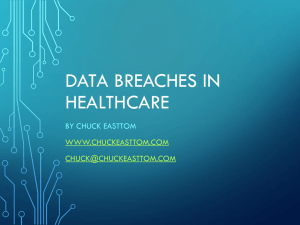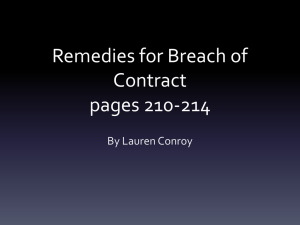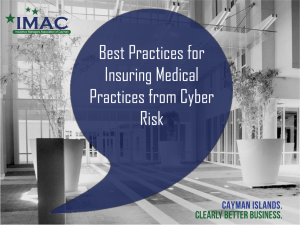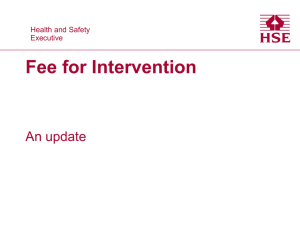2014 GFOA Presentation
advertisement
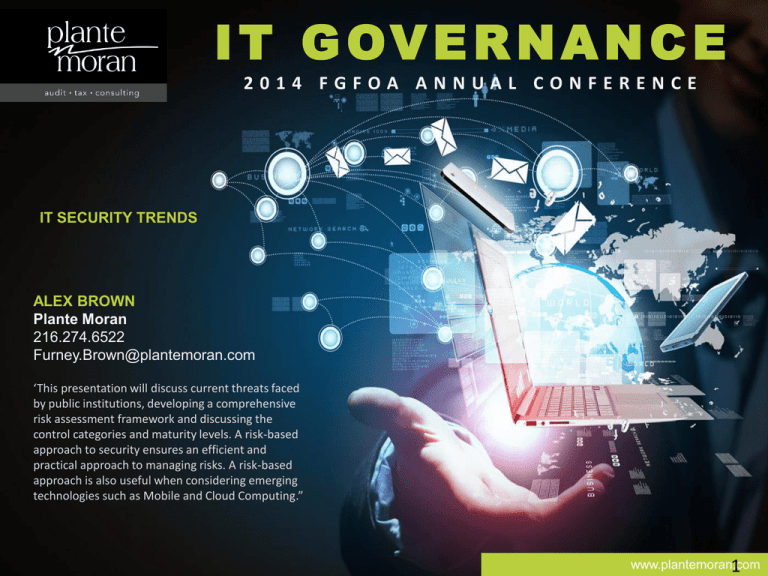
I T G OV E R N A N C E 2014 FGFOA ANNUAL CONFERENCE IT SECURITY TRENDS ALEX BROWN Plante Moran 216.274.6522 Furney.Brown@plantemoran.com ‘This presentation will discuss current threats faced by public institutions, developing a comprehensive risk assessment framework and discussing the control categories and maturity levels. A risk-based approach to security ensures an efficient and practical approach to managing risks. A risk-based approach is also useful when considering emerging technologies such as Mobile and Cloud Computing.” www.plantemoran.com 1 Agenda The Growing World of Information Security Compliance Control Frameworks • COBIT • ISO 27000 • SANS Top 20 Critical Controls • NIST Cyber Security Understanding Threats…. What Can Go Wrong Understanding Controls….. Where Are My Controls What Are My Next Steps Understanding of Information Security The Growing World of Security Sarbanes Oxley HIPAA 95/46/EU DPD GLBA PCI FERPA State Regulation FISMA Canada PIPEDA Australia – Federal Privacy Act 21 CRF Part 11 Japan PIP Are You in Compliance? Plante Moran’s Information Security Governance Model Different organizations view information security differently. Some of the differences are related to varied risk and threat profiles impacting an organization — based on factors such as industry, location, products/services, etc. Other differences are related to management’s view of security based on its experience with prior security incidents. Controls Frameworks – COSO / COBIT MATURITY LEVELS 0. Ad Hoc 1. Initial 2. Repeatable 3. Defined 4. Managed 5. Optimizing 5 Controls Frameworks – ISO 27001 MATURITY LEVELS Controls Frameworks – SANS Top 20 CSC Controls Frameworks - NIST Cyber Security MATURITY LEVELS Tier 1 – Partial Tier 2 – Risk Informed Tier 3 – Repeatable Tier 4 – Adaptive Plante Moran’s Information Security Control Framework Plante Moran’s Information Security Risk Assessment Approach What can go wrong? 11 Where is my data? Type Storage Sharing Where is my data? Type Storage Sharing 13 Where is my data? Type Storage Sharing 14 Threats – Information Security Source: Verizon – 2014 Data Breach Investigations Report Threats – Top Threats • Virus & Malware • Web-based attacks • Stolen Devices • Malicious Code • Malicious Insiders • Phishing / Social Engineering • Denial of Service Source: Ponemon /HP – Cost of Cyber Crime Study Threats – Data Breach Source: Norton Cyber-Crime Index Threats – Cost of Data Breaches Source: 2012 Verizon Data Breach Investigations Report So What is the Cost of a Breach? Symantec Annual Study Global Cost of a Breach – June 5th 2013 Source: Norton Cyber-Crime Index Threats – Recent Data Breach Victims Community Health Systems Data Loss P.F. Chang Credit Card Loss Threats – Recent Data Breach Victims 15000 MTA Data Records Lost Credit Card Exposure at UPS Stores Threats – Recent Municipal Data Breaches City Providence, RI Agency or division No. of records breached Date made public Type of breach* Source: Privacy Rights Clearinghouse. City of Providence 3,000 March 21, 2012 DISC Springfield, Missouri City of Springfield 6,071 February 28, 2012 HACK DISC = unintended disclosure of data; HACK = hacking or malware; Provo, Utah Provo School District 3,200 December 23, 2011 HACK San Francisco, Calif. Human Services Agency of San Francisco 2,400 February 5, 2011 INSD Hingham, Mass. Hingham City Government 1,300 August 4, 2010 DISC Charlotte, NC City of Charlotte 5,220 May 25, 2010 PHYS Atlanta, Georgia Atlanta Firefighters 1,000 April 13, 2010 DISC Detroit, Mich. Detroit Health Department 5,000 December 15, 2009 PORT Indianapolis, Indiana Indianapolis Department of Workforce Development 4,500 May 23, 2009 DISC Culpeper, Va. City of Culpeper 7,845 April 6, 2009 DISC New York, NY New York City Police 80,000 Department March 4, 2009 INSD Source: Norton Cyber-Crime Index INSD = insider malfeasance; PHYS = lost, discarded, or stolen nonelectronic records (as in paper documents); PORT = lost, discarded, or stolen portable electronic devices (laptops, smartphones, etc.); STAT = lost, discarded, or stolen stationary electronic devices (servers, computers, etc.). Threats – Recent Municipal Data Breaches City Agency or division No. of records breached Muskogee, Okla. City of Muskogee Charleston, W.Va. Kanawha-Charleston 11,000 Health Department January 20, 2009 Charlottesville, NC City of Charlottesville November 9, 2008 Indianapolis, Indiana City of Indianapolis 4,500 Date made public 25,000 March 1, 2009 Type of breach* PORT DISC = unintended disclosure of data; PORT HACK = hacking or malware; INSD = insider malfeasance; 3,300 October 15, 2008 DISC Chicago, Ill. Village of Tinley Park 20,400 July 24, 2008 PORT Baltimore, Md. Baltimore Highway Administration 1,800 April 25, 2008 DISC Columbus, Ohio City of Columbus 3,500 September 21, 2007 STAT New York, NY New York City 280,000 Financial Information Services Agency August 23, 2007 PORT Virginia Beach, Va. City of Virginia Beach, Flexible Benefits 2,000 July 27, 2007 INSD Encinitas, Calif. City of Encinitas 1,200 July 13, 2007 DISC Lynchburg, Va. Lynchburg City 1,200 June 14, 2007 DISC Source: Norton Cyber-Crime Index Source: Privacy Rights Clearinghouse. PHYS = lost, discarded, or stolen nonelectronic records (as in paper documents); PORT = lost, discarded, or stolen portable electronic devices (laptops, smartphones, etc.); STAT = lost, discarded, or stolen stationary electronic devices (servers, computers, etc.). Threats – Recent Municipal Data Breaches City Agency or division No. of records breached Date made public Type of breach* Chicago, Ill. Chicago Board of Election 1.3 million January 22, 2007 PORT New York, NY New York City Human Resources Administration, Brooklyn, NY 7,800 December 21, 2006 PORT Lubbock, Texas City of Lubbock 5,800 November 7, 2006 HACK Chicago, Ill. Chicago Voter Database 1.35 million October 23, 2006 DISC Savannah, Georgia City of Savannah 8,800 September 20, 2006 DISC Chicago, Ill. City of Chicago via contractor Nationwide Retirement Solutions Inc. 38,443 September 1, 2006 New York, NY New York City Department of Homeless Services 8,400 July 24, 2006 DISC Hampton, Va. Hampton Circuit Court Clerk, Treasurer's computer Over 100,000 July 14, 2006 DISC Source: Norton Cyber-Crime Index Source: Privacy Rights Clearinghouse. DISC = unintended disclosure of data; HACK = hacking or malware; INSD = insider malfeasance; PORT PHYS = lost, discarded, or stolen nonelectronic records (as in paper documents); PORT = lost, discarded, or stolen portable electronic devices (laptops, smartphones, etc.); STAT = lost, discarded, or stolen stationary electronic devices (servers, computers, etc.). External Threats Profile Internal Threats Profile For smaller organizations, employees directly handling cash/payments (cashiers, waiters, and tellers, etc.) are often more responsible for breaches. In larger organizations, it is the administrators that take the lead. Cyber Crime – State Statistics 97% of Breaches Were Avoidable Most victims aren’t overpowered by unknowable and unstoppable attacks. For the most part, we know them well enough and we also know how to stop them. Verizon Data Breach Investigations Report Weak Infrastructure • • • • • Weak design (firewalls, wireless routers) Weak user authentication (users, passwords) Encryption (VPN, secure portals) Out-dated (patch management/anti-virus) Lack of periodic testing User Ignorance • • • • Weak user passwords Poor judgment Social media Phishing attacks Third-Party Vendors • • • Weak due diligence Breach notification Annual breach confirmation Technology Advances • • Mobile devices Cloud computing/public portals 27 97% of Breaches Were Avoidable Source: 2012 Verizon Data Breach Investigations Report Symantec Annual Study Global Cost of a Breach – June 5th 2013 Where Are My Controls? Secure Network Infrastructure 1. Layer Your Network – Public, Sensitive, Confidential, Private 2. Perimeter Security – Firewalls, IDS/IPS 3. Wireless Security – SSID, Encryption, Default Password 4. Authentication – Users & Passwords 5. Encryption – Connectivity & Storage 6. Anti-virus 7. Patch Management 8. Remote Access 9. Network Monitoring 10. Annual Testing – External Penetration & Internal Security Assessment User Access Management • Full-time employees • Part-time employees and contractors • • Ad hoc vs. formal repeatable process Consultants and vendors • Single sign-on • Customers • User IDs/passwords • Visitors • Use of technology (tokens, firewalls, access points, encryption, etc.) • Need to know basis/able to perform job responsibilities • Only when an issue is noted • User access logs • Segregation of duties • Annual review of access • Administrative access • Proactive review of user activity • Super-user access • • Internet vs. corporate system access Real-time monitoring of unauthorized access or use of information systems User Security Awareness • • • • • • • • Strong password practices Device security Accessing from public places Sharing data with outside parties Loss of hardware Disposal of devices Use of mobile technology Use of online portals 1-800 DATA BREACH I’m flattered, really I am. But you probably shouldn’t use my name as your password. Security Awareness Posters Cloud Computing Choosing a Cloud Vendor • Internal controls at cloud provider • Secure connections/encryption • User account management • Shared servers vs. dedicated servers • Locations of your data • Data ownership • Cost of switch vendors • Other third-parties involved • Service Organization Controls (SOC) reports • Independent network security/ penetration testing (ask for summary report) • Web application testing (if applicable) Cloud Computing - Vendor Due Diligence Due Diligence • Existence and corporate history, strategy, and reputation • References, qualifications, backgrounds, and reputations of company principals, including criminal background checks • Financial status, including reviews of audited financial statements • Internal controls environment, security history, and audit coverage (SOC Reports) • Policies vs. procedures • Legal complaints, litigation, or regulatory actions • Insurance coverage • Ability to meet disaster recovery and business continuity requirements Breach Notification • Contract language should include breach notification requirement • Annual confirmation of breaches by CEO or other C-level executive at the vendor Cloud Computing - Vendor Due Diligence Security Concerns To gain the trust of organizations, cloud-based services must deliver security and privacy expectations that meet or exceed what is available in traditional IT environments. Security and Privacy Expectations Traditional IT In the Cloud LOSS OF GOVERNANCE: Customer relinquishes some control over the infrastructure. TRUST in the provider is paramount. COMPLIANCE RISKS: The providers operational characteristics directly affect the ability for a customer to achieve compliance with appropriate regulations and industry standards. DATA PROTECTION: The customer relinquishes control over their data to the provider. The provider must give demonstrable assurances to the customer that their data is maintained securely from other tenants of the cloud. Where How Mobile Devices Device Security Encryption • Physical security of device • Passwords enable native encryption • Passwords not pins • Encrypted transmission • Enable auto lock • Memory encryption • Secure e-mail/calendar (including sync) Mobile Device Management • Keep Bluetooth devices to “nondiscoverable” (will not impact authenticated connections) • Remote wipe • Failed attempts lock/wipe • Secure backup data on mobile device • Keep all system/applications patches up-to-date • Keep “apps” version current • Great way to manage company owned devices Mobile Devices Mobile Device Considerations Who has access & how is it controlled? Apps can send data in the clear – unencrypted -without user knowledge. Many apps connect to several third-party sites without user knowledge. Unencrypted connections potentially expose sensitive and embarrassing data to everyone on a network. Segregation of personal & bank data 72% of apps present medium (32%) to high (40%) risk regarding personal privacy. 1 Lost device & remote wipe management Only 55% of those allowing personal mobiles in the work place have password policies in place.1 1- net-security.org Mobile Devices In the mobile world, control over customer data is dependent upon: – Device Physical Security – Device Logical Security – App Security Each of which overwhelmingly rely upon an educated end user to be effective So What Do We Do? 40 Information Security Process Risk-Based Information Security Process Perform an Information Security Risk Assessment Designate security program responsibility Develop an Information Security Program Implement information security controls Implement employee awareness and training Regularly test or monitor effectiveness of controls Prepare an effective Incident Response Procedure Manage vendor relationships Periodically evaluate and adjust the Information Security Program 4 Information Security Process 4 Information Security Process 97% of breaches were avoidable - Most victims aren’t overpowered by unknowable and unstoppable attacks. For the most part, we know them well enough and we also know how to stop them. Information Security Program Annual Risk Assessments Strong IT Policies I’m flattered, I really am. But you probably shouldn’t use my name as your password Educate Employees Patch Management Program Deploy Encryption and Strong Authentication Solutions 4 In summary … it’s complicated In summary … now simplified Questions/Comments? Additional Information… THANK YOU A L E X B R O W N | S E N I O R M A N A G E R | I T C O N S U LT I N G 216.274.6522| FURNEY.BROWN@PLANTEMORAN.COM



